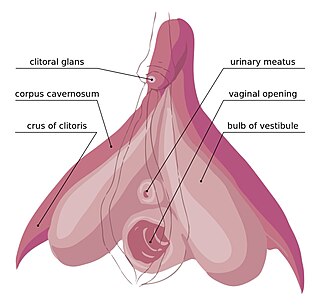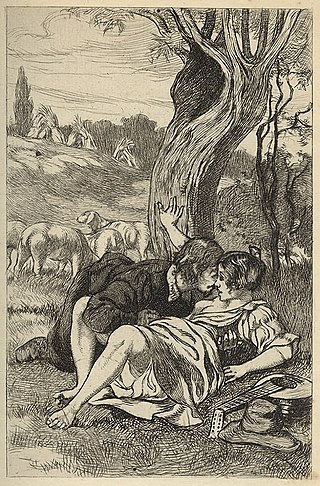Related Research Articles

In amniotes, the clitoris is a female sex organ. In humans, it is the vulva's most erogenous area and generally the primary anatomical source of female sexual pleasure. The clitoris is a complex structure, and its size and sensitivity can vary. The visible portion, the glans, of the clitoris is typically roughly the size and shape of a pea and is estimated to have at least 8,000 nerve endings.
Erectile dysfunction (ED), also referred to as impotence, is a form of sexual dysfunction in males characterized by the persistent or recurring inability to achieve or maintain a penile erection with sufficient rigidity and duration for satisfactory sexual activity. It is the most common sexual problem in males and can cause psychological distress due to its impact on self-image and sexual relationships.

Orgasm or sexual climax is the sudden discharge of accumulated sexual excitement during the sexual response cycle, resulting in rhythmic, involuntary muscular contractions in the pelvic region characterized by sexual pleasure. Experienced by males and females, orgasms are controlled by the involuntary or autonomic nervous system. They are usually associated with involuntary actions, including muscular spasms in multiple areas of the body, a general euphoric sensation, and, frequently, body movements and vocalizations. The period after orgasm is typically a relaxing experience, attributed to the release of the neurohormones oxytocin and prolactin as well as endorphins.

In male human anatomy, the glans penis or penile glans, commonly referred to as the glans, is the bulbous structure at the distal end of the human penis that is the human male's most sensitive erogenous zone and primary anatomical source of sexual pleasure. The glans penis is present in the male reproductive organs of humans and most other mammals where it may appear smooth, spiny, elongated or divided. It is externally lined with mucosal tissue, which creates a smooth texture and glossy appearance. In humans, the glans is located over the distal ends of the corpora cavernosa and is a continuation of the corpus spongiosum of the penis. At the summit appears the urinary meatus and at the base forms the corona glandis. An elastic band of tissue, known as the frenulum, runs on its ventral surface. In men who are not circumcised, it is completely or partially covered by a fold of skin called the foreskin. In adults, the foreskin can generally be retracted over and past the glans manually or sometimes automatically during an erection.

Priapism is a condition in which a penis remains erect for hours in the absence of stimulation or after stimulation has ended. There are three types: ischemic (low-flow), nonischemic (high-flow), and recurrent ischemic (intermittent). Most cases are ischemic. Ischemic priapism is generally painful while nonischemic priapism is not. In ischemic priapism, most of the penis is hard; however, the glans penis is not. In nonischemic priapism, the entire penis is only somewhat hard. Very rarely, clitoral priapism occurs in women.

The G-spot, also called the Gräfenberg spot, is characterized as an erogenous area of the vagina that, when stimulated, may lead to strong sexual arousal, powerful orgasms and potential female ejaculation. It is typically reported to be located 5–8 cm (2–3 in) up the front (anterior) vaginal wall between the vaginal opening and the urethra and is a sensitive area that may be part of the female prostate.

Penis enlargement, or male enhancement, is any technique aimed to increase the size of a human penis. Some methods aim to increase total length, others the shaft's girth, and yet others the glans size. Techniques include surgery, supplements, ointments, patches, and physical methods like pumping, jelqing, and traction.
Erectile tissue is tissue in the body with numerous vascular spaces, or cavernous tissue, that may become engorged with blood. However, tissue that is devoid of or otherwise lacking erectile tissue may also be described as engorging with blood, often with regard to sexual arousal.

Epididymal hypertension (EH), informally referred to as blue balls for males or blue vulva for females, is a harmless but uncomfortable sensation in the genital regions during a prolonged state of sexual arousal. It usually resolves within hours unless relieved through an orgasm.

In female anatomy, the vestibular bulbs, bulbs of the vestibule or clitoral bulbs are two elongated masses of erectile tissue typically described as being situated on either side of the vaginal opening. They are united to each other in front by a narrow median band. Some research indicates that they do not surround the vaginal opening, and are more closely related to the clitoris than to the vestibule. They constitute the root of the clitoris along with the crura.

A corpus cavernosum penis (singular) is one of a pair of sponge-like regions of erectile tissue, which contain most of the blood in the penis during an erection.

The corpus cavernosum of clitoris is one of a pair of sponge-like regions of erectile tissue of the clitoris. It is made of a sponge-like tissue that fills with blood during erection. This is homologous to the corpus cavernosum penis. The term corpora cavernosa literally means "cave-like bodies".
Nocturnal penile tumescence (NPT) is a spontaneous erection of the penis during sleep or when waking up. Along with nocturnal clitoral tumescence, it is also known as sleep-related erection. Men without physiological erectile dysfunction or severe depression experience nocturnal penile tumescence, usually three to five times during a period of sleep, typically during rapid eye movement sleep. Nocturnal penile tumescence is believed to contribute to penile health.
Clitoral enlargement methods are forms of body modification that have the potential to increase the size of the clitoris and enhance sexual pleasure. Clitoral enlargement can be accomplished through a variety of means, each potentially having certain side effects and risks.

In human anatomy, the penis is an external male sex organ that additionally serves as the urinary duct. The main parts are the root, body, the epithelium of the penis including the shaft skin, and the foreskin covering the glans. The body of the penis is made up of three columns of tissue: two corpora cavernosa on the dorsal side and corpus spongiosum between them on the ventral side. The urethra passes through the prostate gland, where it is joined by the ejaculatory duct, and then through the penis. The urethra goes across the corpus spongiosum and ends at the tip of the glans as the opening, the urinary meatus. It is a passage both for excretion of urine and the ejaculation of semen.

An erection is a physiological phenomenon in which the penis becomes firm, engorged, and enlarged. Penile erection is the result of a complex interaction of psychological, neural, vascular, and endocrine factors, and is often associated with sexual arousal, sexual attraction or libido, although erections can also be spontaneous. The shape, angle, and direction of an erection vary considerably between humans.

Clitoral erection is a physiological phenomenon where the clitoris becomes enlarged and firm.
The following outline is provided as an overview of and topical guide to human sexuality:

Sexual arousal describes the physiological and psychological responses in preparation for sexual intercourse or when exposed to sexual stimuli. A number of physiological responses occur in the body and mind as preparation for sexual intercourse, and continue during intercourse. Male arousal will lead to an erection, and in female arousal, the body's response is engorged sexual tissues such as nipples, clitoris, vaginal walls, and vaginal lubrication.
Nocturnal clitoral tumescence (NCT), colloquially known as morning bean, is a spontaneous swelling of the clitoris during sleep or when waking up. Similar to the process in males, nocturnal penile tumescence, females experience clitoris tumescence and engorgement of the vagina mainly during the REM sleep phase.
References
- ↑ "Tumescence: The Sexual Response - The Female Response". Archive of Sexology. Humboldt Universität zu Berlin. Archived from the original on 1 July 2006. Retrieved 26 January 2021.
- ↑ "1. Excitement: The Sexual Response - The Male Response". Archive of Sexology. Humboldt Universität zu Berlin. Archived from the original on 4 July 2007. Retrieved 26 January 2021.
- ↑ Bella, Anthony J.; Lue, Tom F. "Chapter 38. Male Sexual Dysfunction". In Tanagho, EA; McAninch, JW (eds.). Smith's General Urology (17th ed.). as DOC file at zju.edu.cn. Archived from the original on 2018-07-21.
- ↑ McFarlane, Gordon A.; Sammon, Alastair M. (2000). "A prepaid healthcare scheme in rural Africa". Tropical Doctor . 30 (3): 151–54. doi:10.1177/004947550003000313. PMID 10902473. S2CID 29060115.